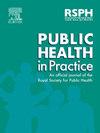Hepatitis B vaccination coverage and associated factors among children living in northwest Ethiopia city administrations: A community-based study
IF 1.9
Q2 PUBLIC, ENVIRONMENTAL & OCCUPATIONAL HEALTH
引用次数: 0
Abstract
Objective
A study was being conducted to assess the current vaccination coverage, dropout rates, and associated risk factors in children under 15 years old in northwest Ethiopia.
Study design
A community-based cross-sectional survey.
Methods
A community-based survey was conducted in northwest Ethiopia from January to March 2024. A two-stage cluster-sampling technique was used to select a representative sample. Sociodemographic information, vaccination history, and epidemiological risk factors were collected using a pre-tested, structured questionnaire. Data analysis was performed using SPSS version 23, employing descriptive statistics, chi-square test, and logistic regression model. Associations of vaccination determinants were investigated, with a p-value <0.05 considered statistically significant.
Results
In the study, 808 children were surveyed, with 53.0 % being female and 53.0 % were born at hospitals. Most (52.5 %) were under 5 years old, with a mean age of 5.4 ± 3.5 years. Seven hundred thirty four (90.8 %) had received at least one dose of the hepatitis B vaccine, and 82.7 % had received three doses, with a 9.0 % dropout rate. Among children completely vaccinated against hepatitis B, 366 (54.8 %) were in the age group of 1–4 years. The vaccination coverage was 85.4 %, 82.9 %, and 76.5 % in Bahir Dar, Gondar, and Debre Markos, respectively. Several factors have been identified as predictors of complete hepatitis B vaccination in children, including mothers who attended primary school (AOR = 2.9; 95 % CI: 1.4–5.8) and those with secondary education or higher (AOR = 2.2; 95 % CI: 1.3–4.0), married mothers (AOR = 2.5; 95 % CI: 1.5–4.3), and mothers aged 21–30 years (AOR = 2.7; 95 % CI: 1.3–5.6) and those aged 31–40 years (AOR = 2.8; 95 % CI: 1.4–5.5) were more likely to have their children fully vaccinated. Additionally, children born in hospitals (AOR = 2.4; 95 % CI: 1.3–4.3) or health centers (AOR = 4.0; 95 % CI: 2.2–7.4), increased access to vaccination services (AOR = 2.5; 95 % CI: 1.5–4.3), children aged 1–4 years (AOR = 3.1; 95 % CI: 1.7–5.5) and 5–9 years (AOR = 3.8; 95 % CI: 2.1–7.1) had higher HB vaccination coverage.
Conclusion
The complete hepatitis B vaccination coverage in this study was lower than the WHO recommendation for developing countries. Therefore, enhancing the promotion of facility delivery and ensuring easy access to vaccines are crucial for improving children's vaccination coverage.
生活在埃塞俄比亚西北部城市管理部门的儿童的乙型肝炎疫苗接种覆盖率及其相关因素:一项基于社区的研究
目的开展一项研究,评估埃塞俄比亚西北部15岁以下儿童目前的疫苗接种覆盖率、辍学率和相关危险因素。研究设计:基于社区的横断面调查。方法2024年1 - 3月在埃塞俄比亚西北部进行社区调查。采用两阶段整群抽样技术选择有代表性的样本。使用预先测试的结构化问卷收集社会人口统计信息、疫苗接种史和流行病学危险因素。数据分析采用SPSS version 23,采用描述性统计、卡方检验和logistic回归模型。研究了疫苗接种决定因素的相关性,p值<;0.05被认为具有统计学意义。结果共调查儿童808名,其中53.0%为女婴,53.0%在医院出生。5岁以下占52.5%,平均年龄5.4±3.5岁。734人(90.8%)接种了至少一剂乙肝疫苗,82.7%接种了三剂,辍学率为9.0%。在完全接种乙型肝炎疫苗的儿童中,有366名(54.8%)是1-4岁年龄组的儿童。在巴希尔达尔、贡达尔和德布雷马科斯,疫苗接种率分别为85.4%、82.9%和76.5%。已经确定了几个因素作为儿童完全接种乙型肝炎疫苗的预测因素,包括上过小学的母亲(AOR = 2.9;95% CI: 1.4-5.8)和中等或更高学历(AOR = 2.2;95% CI: 1.3-4.0),已婚母亲(AOR = 2.5;95% CI: 1.5-4.3), 21-30岁母亲(AOR = 2.7;95% CI: 1.3-5.6)和31-40岁(AOR = 2.8;95% CI: 1.4-5.5)更有可能让他们的孩子完全接种疫苗。此外,在医院出生的儿童(AOR = 2.4;95% CI: 1.3-4.3)或健康中心(AOR = 4.0;95% CI: 2.2-7.4),增加获得疫苗接种服务的机会(AOR = 2.5;95% CI: 1.5-4.3), 1-4岁儿童(AOR = 3.1;95% CI: 1.7-5.5)和5-9年(AOR = 3.8;95% CI: 2.1-7.1) HB疫苗接种率较高。结论本研究的乙肝疫苗接种覆盖率低于世卫组织对发展中国家的建议。因此,加强促进设施提供和确保容易获得疫苗对于提高儿童疫苗接种覆盖率至关重要。
本文章由计算机程序翻译,如有差异,请以英文原文为准。
求助全文
约1分钟内获得全文
求助全文

 求助内容:
求助内容: 应助结果提醒方式:
应助结果提醒方式:


